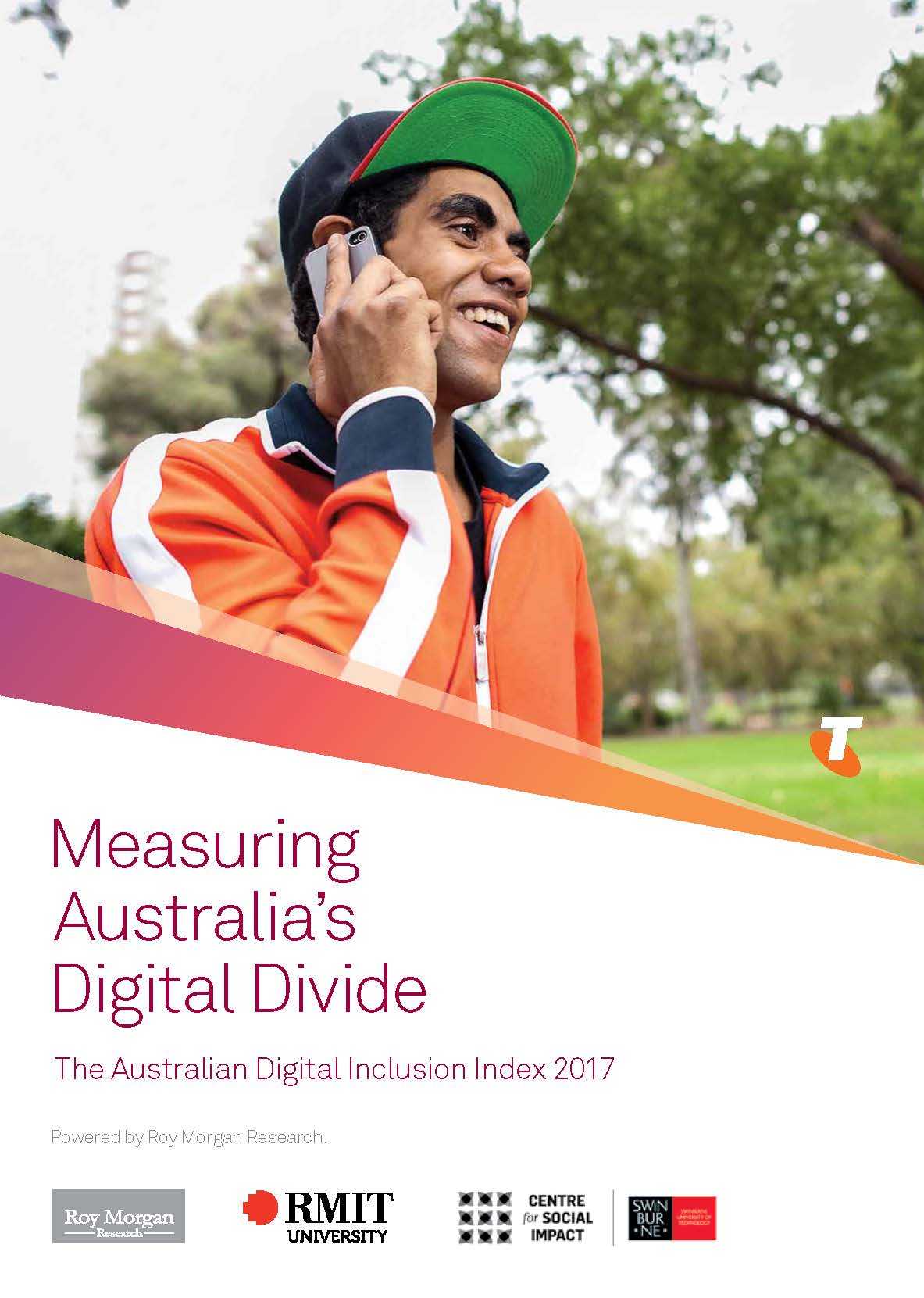This case study was originally published in the 2017 Australian Digital Inclusion Index report, and is derived from the Roy Morgan Single Source dataset. As of 2021, the Australian Digital Inclusion Index is based on the Australian Internet Usage Survey (AIUS). The numerical results of this case study cannot be compared with the refreshed ADII data.
The ADII presents useful data on digital inclusion and disability. However, it is important to remember that our data defines disability as people who receive either the disability support pension (DSP) from Centrelink (83% of these respondents), or the Department of Veterans’ Affairs disability pension (17%). The DSP is means tested, and while the Veterans’ Affairs disability pension is not, most people receiving this latter payment report a below-average household income. The ADII results therefore represent outcomes for a distinct group within the wider community of Australians with disability.
In 2017 the ADII reveals a mixed picture for the digital inclusion of people with a disability. Since 2014, scores for this cohort have increased nationally (up 5.2 points, to 47.0), in capital cities (up 5.4 points to 47.9), and across rural Australia (up 5.3 points to 45.1). Scores for both women and men with disability have increased since 2014, with women scoring marginally higher than men. However, Affordability remains an issue, confirming the findings of earlier Australian research.1 At 46.0, the Affordability score for men with disability is lower than the national (male) average of 53.7. Similarly, Affordability for women with disability is 42.7 compared with the national average of 51.7.
Despite these improved scores, digital inclusion remains relatively low for people with a disability. Their national score of 47.0 is still 9.5 points behind the Australia-wide score of 56.5. This ‘disability gap’ is wider in capital cities, but narrower in rural Australia.
Age influences digital inclusion for Australians with disability, with those aged 35–49 recording higher scores than those aged 50–64 years (49.2 and 42.0 respectively).2 Interestingly, in 2017 the ADII score for Australians with disability aged 65+ rose above the score for the same age group without a disability for the first time (45.5 versus 42.9). This suggests mainstream digital inclusion programs could learn from the experience and motivations of older Australians with disability.
Education also plays a key role in digital inclusion for people with a disability. The ADII score for tertiary-educated Australians with disability is 53.8, compared with 49.7 for those with a secondary education, and just 40.0 for those who did not complete secondary school.
Digital Ability research in Australia has considered the importance of accessibility. However, studies have focused primarily on ensuring the accessibility and usability of digital content and technology3, rather than improving access to digital infrastructure. The ADII data suggests unequal access to digital infrastructure may present another potential barrier to digital inclusion for people with a disability.
Affordability has long been recognised as relevant to the digital inclusion of Australians with disability.4 People with a disability in Sydney, Melbourne, and Brisbane all scored significantly lower on this sub-index than their fellow residents.
Given that large cities typically provide more opportunities to participate in low-cost digital skills training, the relatively low Digital Ability scores for people with disability in these cities is surprising. This suggests additional, as-yet unidentified barriers to digital inclusion for this group, and a need for accessibility training in the use of digital technology.5
The ADII reveals how age, gender, and education impact on the digital inclusion of people with a disability. The results raise important questions about how this group can realise the full benefits of a digital era, including access to the NDIS.
Furthermore, the ADII suggests the need for further research on Australians with disability who do not receive a pension or benefit. The Disability, Ageing and Carers survey (Australian Bureau of Statistics) could be extended to collect more information on digital inclusion; and in-depth studies of particular groups with a disability, such as Indigenous Australians, could address other gaps in our understanding.
Further information
For more information, including related data tables and the full citation list, please refer to the 2017 Australian Digital Inclusion Index.
References and footnotes
[1] Morsillo, R. (2011). One down, two to go: public policy in service of an available, affordable and accessible National Broadband Network for people with disability. Telecommunications Journal of Australia, 61(2), pp. 28.1-28.13; Goggin, G., Hollier, S. and Hawkins, W. (2017). Internet accessibility and disability policy: lessons for digital inclusion and equality from Australia. Internet Policy Review, 6(1).
[2] The sample size for persons with disability aged 14–24 and 24–34 is too small to enable analysis of changes in the ADII.
[3] Ellis, K. and Kent, M. (2003). Digital disability: the social construction of disability in new media. Choice Reviews Online, 41(01), pp. 41-0382-41-0382; Ellis, K. and Kent, M. (2011). Disability and New Media. 1st ed. New York: Routledge.
[4] Morsillo, R. (2011). One down, two to go: public policy in service of an available, affordable and accessible National Broadband Network for people with disability. Telecommunications Journal of Australia, 61(2), 28.1–28.13; Australian Communications Consumer Action Network (2015). Access to the internet for persons with disabilities and specific needs. Submission by the Australian Communications Consumer Action Network to the ITU CWG – Internet. ACCAN; Australian Communications Consumer Action Network (2016). Affordability Map. ACCAN; and Goggin, G. & Hollier, S. and Hawkins, W. (2017). Internet accessibility and disability policy: lessons for digital inclusion and equality from Australia. Internet Policy Review, 6(1).
[5] Garrett, R. and Nguyen, T. (2012). Together we can find telecommunication solutions for people with complex communication needs. Telecommunications Journal of Australia, 62(2), 26.1–26.13.
Citation
Thomas, J, Barraket, J, Wilson, C, Ewing, S, MacDonald, T, Tucker, J & Rennie, E, 2017, Measuring Australia’s Digital Divide: The Australian Digital Inclusion Index 2017, RMIT University, Melbourne, for Telstra. DOI: www.dx.doi.org/10.4225/50/







